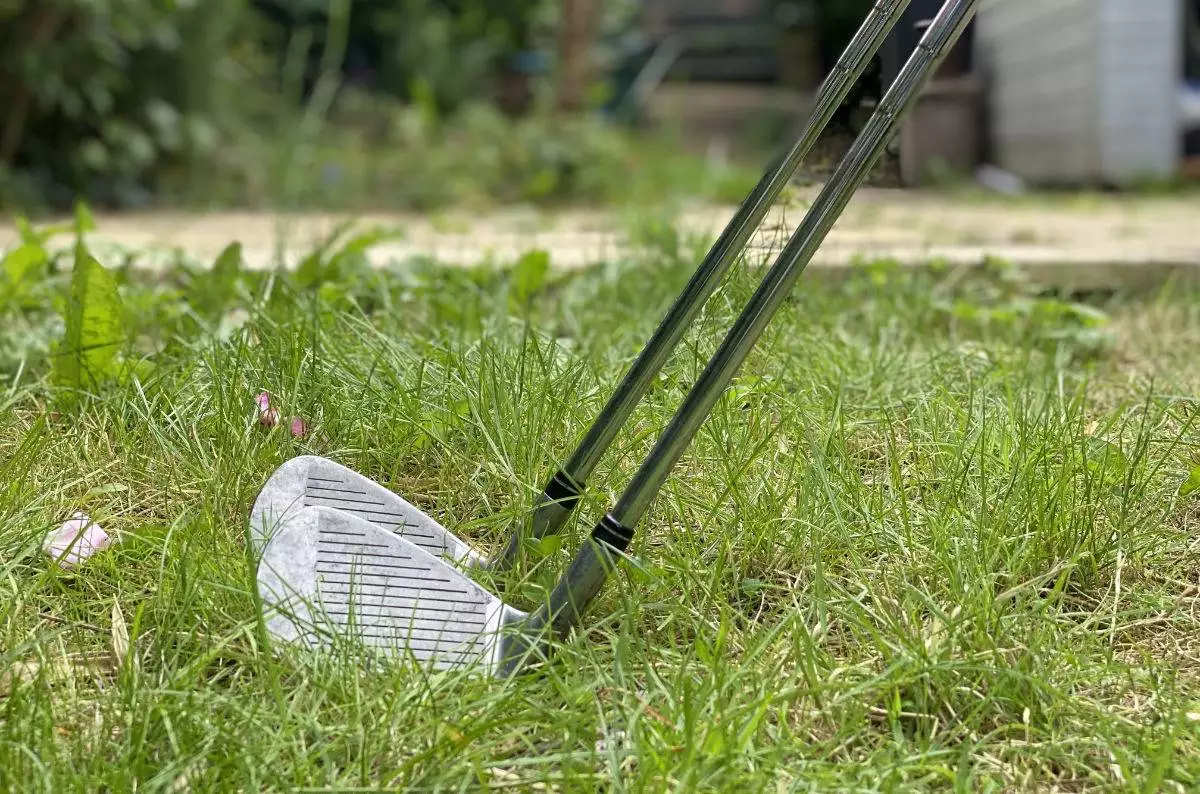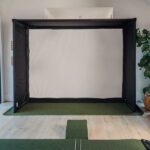The short game is a crucial part of golf to shoot your best scores possible.
Learning how to master your 9 iron and pitching wedge can help you shave off strokes from your score quickly.
In this article, we will discuss the key differences between a 9 iron, when to use 9-iron, when to use pitching wedge and more.
9 Iron vs Pitching Wedge
Every golfer can have 14 clubs but it’s easy to get confused on which club works for each type of shot.
Most complete sets of golf clubs on the market today include a 9 iron and pitching wedge. Some sets include a gap wedge or sand wedge also.
Key Differences Between a 9 Iron and Pitching Wedge
So, what’s the difference, is a pitching wedge the same as a 9-iron? Is a 9-iron a wedge of sorts?
No, they’re very similar but there are two important differences between each club:
- A pitching wedge has more loft than a 9-iron.
- A pitching wedge is slightly shorter than a 9-iron and easier to control.
Plus, a pitching wedge is used more around the greens for different chip shots too.
Loft and Lie Angle
A 9 iron has less loft, making it go longer than a PW (or any type of wedge). A typical 9-iron has a loft between 38–42 degrees, depending on the iron set.
Game improvement clubs tend to have less loft which makes it easier to hit the ball further. These are great choices for newer golfers who don’t generate as much natural swing speed.
A pitching wedge has a loft angle of 43–48 degrees depending on the brand and model. A pitching wedge is typically easier to hit than the 9-iron with a higher launch angle and more spin.
Another difference between the two clubs is lie angle.
Here’s how Golf.com described lie angle, “Measurement of the angle formed by the hosel/shaft and the ground when the head is at rest or when the grooves are parallel with the ground. The greater the lie angle, the more “upright” the club is. The less the lie angle, the more “flat” the club is.”
The longer the club, the less lie angle. A 9 iron has .25 degrees less lie angle (or more) and generally is around 63.0 while a PW has 63.25 degrees.
Length
The other big difference between a 9-iron and pitching wedge is the length.
The lower number of an iron, the longer it is – which is why a 5-iron is longer than a short iron or wedge. With the driver being the longest club in the bag.
Since a 9-iron is longer – typically only .25 inches or so – paired with less loft, it makes it easier to hit this club longer distances. But the ball flight will be lower with a 9-iron than a pitching wedge.
A 9-iron is typically 36 inches long, while a pitching wedge is 35.5 to 35.75 inches long.
This is due to the difference in loft angles; a higher loft angle requires a shorter club length to produce the same ball flight.
Plus, a 9-iron has more offset than a pitching wedge in beginner sets which makes it slightly more forgiving.
Pitching Wedge vs. 9-Iron Distance
The next big difference between these two clubs is distance.
Since a 9-iron is longer and has less loft it will go further than a pitching wedge. In general, this is between 7-15 yards difference depending on the player, swing speed, golf clubs, and other factors.
Most golfers hit their 9 iron around 120 to 140 yards, while a PW is between 100 and 120 yards.
It’s important to hit balls on the driving range or use a personal launch monitor to measure each club’s distance. This way you can swing with confidence from any distance on the golf course.
Now let’s get into when to use each club on the golf course.
When to Use Pitching Wedge (PW vs. 9-Iron Debate)
Since both clubs are quite similar in terms of design, it’s easy to get confused on when to use each one on the golf course.
So let’s get into what a pitching wedge is used for and where a 9-iron is a better option.
Approach Shots
Once you practice with your clubs, find a full swing distance for your 9-iron and PW. For example, you might hit your 9-iron 130 yards (with a full swing) and PW 120 yards.
On approach shots use the right club based on the distance, wind, lie, and other factors.
What’s great about both of these clubs is that you can use them from the fairway or rough with ease. They’re also easy to hit from a fairway bunker as well since they can launch the ball quickly and get over the bunker lip.
If you need a lower flighted shot when hitting into the wind, choose a 9-iron. If you need a higher shot to hit over trees or other obstacles, choose a pitching wedge.
Overall, both clubs are great to use when hitting into a green and definitely a good scoring opportunity.
Par 3s
If you’re teeing off on a short par 3 both clubs are great options.
Make sure to remember that when hitting off a tee you might add a few more yards to your total distance as you’ll generally make better contact.
Also, it’s a good idea to aim at the center of the green if you’re a beginner to give yourself the best chance for a birdie putt.
Bump and Run Shots
Since both clubs have plenty of loft, these are great clubs to use around the greens for a simple chip shot.
A bump-and-run shot is where you hit the ball low off the ground, so it runs onto the green like a putt.
If you have more green to work with, use a 9-iron. If you’re more short sided use a PW or possibly a more lofted wedge like a gap or sand wedge.
Both clubs can help with these shots as they’re very easy to play compared to a high-lofted pitch or flop shot.
Long Bunker Shots
A PW is a great choice if you find yourself with a 20-30 yard bunker shot.
Unless it’s a really long bunker shot, 30 – 40 yards, leave your 9-iron in the bag for these shots.
If you’re in a greenside bunker for a short shot make sure to use a sand wedge or lob wedge instead.
Chip Out
If you hit a wayward drive in the trees and need to get back in position, both clubs can help get you out of trouble.
But just remember they both a PW and 9-iron have a lot of loft compared to mid or long irons so they’ll launch higher.
If you need to keep the golf ball low to avoid hitting trees, you might need an 8-iron or less.
Closing Thoughts
Whether you are facing a long approach shot, short par 3, or need to clear a hazard, selecting the right club can be a huge factor in your success. Both a 9 iron and pitching wedge will usually give you enough height and spin for most of these shots.
Make sure you know your distances and select the club that will give you the best chance to hit your target. With practice, your accuracy and confidence with these clubs will improve and you’ll be seeing lower scores in no time.
Do you like using a PW or 9-iron from around the greens?
Related Articles
- Golf Clubs for Beginners: What Do I Need in My Bag?
- What is a 5 Iron Golf Club? Length, Distance & Loft
- What is a 6 Iron Golf Club? Length, Distance & Loft
- What is a 7 Iron Golf Club? Length, Distance & Loft
- What is a 8 Iron Golf Club? Length, Distance & Loft
- What is a 9 Iron Golf Club? Length, Distance & Loft





